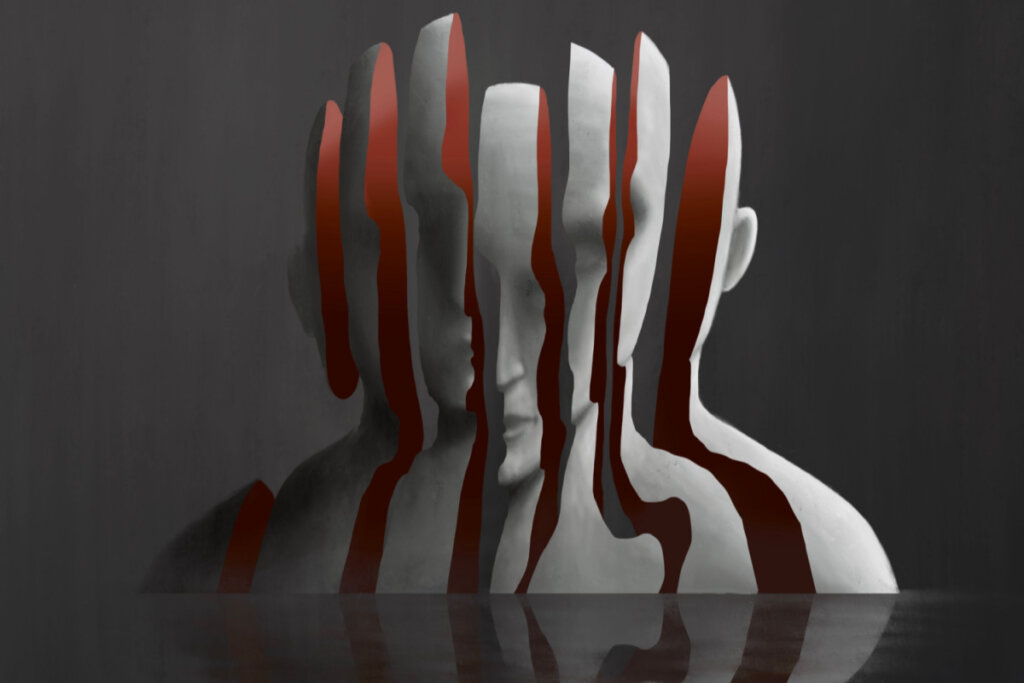How to Deactivate the Triad of Negative Thoughts in Depression


Written and verified by the psychologist Valeria Sabater
“No one will ever love me again”. “I’m worthless”. “My life is a mess”. “All I’m good for is disappointing everyone”. “Things will never change”. Many of our daily thoughts are negative. Moreover, they’re like quicksand in which we sink.
Although it’s true that the development of depression depends on multiple factors, mental focus plays a fundamental role. So much so that figures like Aaron Beck understood and explained this psychological disorder from a cognitive perspective. These experts believed that the internal world of the individual and their subjective beliefs cause this kind of suffering.
In fact, Beck used this same framework to formulate the theory known as the cognitive triad of depression. It’s a valuable concept. Indeed, no one denies the fact that, for sufferers of mood disorders, what they tell themselves matters. Consequently, the way they process their reality and perceive themselves can either be a blessing or a curse.
“If our thinking is bogged down by distorted symbolic meanings, illogical reasoning, and erroneous interpretations, we become, in truth, blind and deaf.”
-Aaron T. Beck-

The triad of negative thoughts in depression
When you talk to a person who’s been dealing with depression for some time, you become aware of a certain factor. They’re weighted down by hopelessness and certain aspects of their existence no longer make sense to them. Furthermore, their ideas and beliefs are exhausting and annihilate their moods and feelings of motivation.
The triad of negative thoughts in depression suggests that this condition is built from three components. After many years of research and psychotherapy, Aaron Beck identified the inherent cognitive processes that shape this disorder. His theoretical model is widely accepted and considered to be extremely relevant.
Studies conducted by Dr. Ernest Edward Beckham, from the University of Oklahoma (USA), highlight the usefulness of applying an instrument that detects and evaluates this type of thought. In fact, understanding the mental architecture of a patient facilitates the therapeutic approach. Now, we’re going to explore the three pillars that support this theory.
Distorted thoughts and patterns of how we perceive ourselves can shape the basis of depression.
1. Cognitive biases
Cognitive biases are distorted and self-defeating thought processes. They’re responsible for making us see the world and the reality that surrounds us in an adverse, negative, and hopeless way. As a rule, these distortions are based on the following kinds of reasoning:
- The ‘shoulds’ and ‘have tos’.
- Overgeneralization (everything will go wrong).
- Personalization (My mother’s sad, it must be my fault).
- Dichotomous thinking or black or white thinking (Things are either good or bad).
- Labeling based on certain results (I was wrong then, so I’m still a failure).
- Arbitrary inference or drawing hasty conclusions (My partner hasn’t called me. He must’ve left me.)
2. Negative self-schemas
A thought schema is like a package of ideas that we integrate over specific dimensions. Many of our self-referential schemas (the way we see ourselves) originate in childhood. In fact, the way in which our parents, teachers, and figures in the environment addressed us can outline a series of extremely negative ideas about ourselves.
The problem is that we’re often unaware of how these internal schemas condition us and mediate our feelings of discomfort.
3. Errors in logic (faulty information processing)
The last factor in the triad of negative thoughts in depression is defined by an illogical way of processing situations. To this component are added the two previous ones: the cognitive biases and the internal schemas concerning how we perceive ourselves.
These two elements create a highly flawed filter that makes the depression sufferer experience each situation in a really debilitating way. They see any problem as insurmountable. Therefore, they’ll handle any interaction, objective, or obligation in the worst possible way. Firstly, due to the fact that their thinking is clouded by their cognitive biases. Secondly, they’re full of insecurities.
According to Aaron Beck, depressed people integrate a negative schema of the world and of themselves at an early age. Making them visible and becoming aware of them is the first step.

How to disable the triad of negative thoughts
The triad of negative thoughts in depression must be addressed through a well-structured therapeutic process. The psychologist trained in cognitive therapy knows that the sufferer of depression daily reinforces a series of negative thoughts about themselves, the world, and what the future may bring.
For this reason, the objective is to replace dysfunctional thinking with a healthier kind. These are the mechanisms for carrying it out:
Identifying underlying cognitive processes
The psychologist identifies the biases, beliefs, and dysfunctional schemas that reinforce depression. Often, an individual’s mental universe is like a scientific paradigm. They have to discover the variables that are creating such an altered and problematic version of reality.
Educating the patient on their disorder
The patient must be an active agent of change and become aware of how they think and interpret each circumstance. To deactivate the triad of negative thoughts, they must learn about their psychological disorder. This implies knowing the effect of their cognitive biases and their obligation to hold certain beliefs.
Cognitive challenging through Socratic dialogue
Socratic dialogue is a powerful tool in cognitive therapy settings. Through a series of specific questions, it makes it easier for the patient to reflect on certain internal realities. They’re dialectical challenges that simplify a reframing of certain perspectives and conceptions.
Getting the patient to question themselves and manage to shape a healthier and more hopeful mental focus is the ultimate goal. They achieve this through guided learning as they explore every bias, schema, and belief.
Counteracting the influence of automatic processing
As we mentioned earlier, many beliefs and thought processes originate in childhood. In effect, the individual becomes so used to processing reality automatically that they’re unaware of the adverse components that are distorting their reality. Another aim of this therapy is to shape more deliberate and reflective thoughts.
The automatic thoughts of negative valence are extremely common in depressive states. Therefore, it’s essential that the sufferer takes control of their mind by avoiding erratic reasoning and negative filtering. Only by doing this will they be able to gradually replace their disabling approaches with healthier mental perspectives.
Conclusion
People are often the product of a compendium of self-fulfilling prophecies, biased ideas, and irrational thoughts. We all exhibit more than one of these self-defeating behaviors. The answer lies in not giving them power, being aware that they’re there, and prioritizing more resilient, reflective, and motivating mental perspectives.
However, sometimes, discouragement overcomes us and a tangle of negative thoughts leaves us with no room for hope. That’s the point at which we should, without a doubt, ask for specialized help.
“No one will ever love me again”. “I’m worthless”. “My life is a mess”. “All I’m good for is disappointing everyone”. “Things will never change”. Many of our daily thoughts are negative. Moreover, they’re like quicksand in which we sink.
Although it’s true that the development of depression depends on multiple factors, mental focus plays a fundamental role. So much so that figures like Aaron Beck understood and explained this psychological disorder from a cognitive perspective. These experts believed that the internal world of the individual and their subjective beliefs cause this kind of suffering.
In fact, Beck used this same framework to formulate the theory known as the cognitive triad of depression. It’s a valuable concept. Indeed, no one denies the fact that, for sufferers of mood disorders, what they tell themselves matters. Consequently, the way they process their reality and perceive themselves can either be a blessing or a curse.
“If our thinking is bogged down by distorted symbolic meanings, illogical reasoning, and erroneous interpretations, we become, in truth, blind and deaf.”
-Aaron T. Beck-

The triad of negative thoughts in depression
When you talk to a person who’s been dealing with depression for some time, you become aware of a certain factor. They’re weighted down by hopelessness and certain aspects of their existence no longer make sense to them. Furthermore, their ideas and beliefs are exhausting and annihilate their moods and feelings of motivation.
The triad of negative thoughts in depression suggests that this condition is built from three components. After many years of research and psychotherapy, Aaron Beck identified the inherent cognitive processes that shape this disorder. His theoretical model is widely accepted and considered to be extremely relevant.
Studies conducted by Dr. Ernest Edward Beckham, from the University of Oklahoma (USA), highlight the usefulness of applying an instrument that detects and evaluates this type of thought. In fact, understanding the mental architecture of a patient facilitates the therapeutic approach. Now, we’re going to explore the three pillars that support this theory.
Distorted thoughts and patterns of how we perceive ourselves can shape the basis of depression.
1. Cognitive biases
Cognitive biases are distorted and self-defeating thought processes. They’re responsible for making us see the world and the reality that surrounds us in an adverse, negative, and hopeless way. As a rule, these distortions are based on the following kinds of reasoning:
- The ‘shoulds’ and ‘have tos’.
- Overgeneralization (everything will go wrong).
- Personalization (My mother’s sad, it must be my fault).
- Dichotomous thinking or black or white thinking (Things are either good or bad).
- Labeling based on certain results (I was wrong then, so I’m still a failure).
- Arbitrary inference or drawing hasty conclusions (My partner hasn’t called me. He must’ve left me.)
2. Negative self-schemas
A thought schema is like a package of ideas that we integrate over specific dimensions. Many of our self-referential schemas (the way we see ourselves) originate in childhood. In fact, the way in which our parents, teachers, and figures in the environment addressed us can outline a series of extremely negative ideas about ourselves.
The problem is that we’re often unaware of how these internal schemas condition us and mediate our feelings of discomfort.
3. Errors in logic (faulty information processing)
The last factor in the triad of negative thoughts in depression is defined by an illogical way of processing situations. To this component are added the two previous ones: the cognitive biases and the internal schemas concerning how we perceive ourselves.
These two elements create a highly flawed filter that makes the depression sufferer experience each situation in a really debilitating way. They see any problem as insurmountable. Therefore, they’ll handle any interaction, objective, or obligation in the worst possible way. Firstly, due to the fact that their thinking is clouded by their cognitive biases. Secondly, they’re full of insecurities.
According to Aaron Beck, depressed people integrate a negative schema of the world and of themselves at an early age. Making them visible and becoming aware of them is the first step.

How to disable the triad of negative thoughts
The triad of negative thoughts in depression must be addressed through a well-structured therapeutic process. The psychologist trained in cognitive therapy knows that the sufferer of depression daily reinforces a series of negative thoughts about themselves, the world, and what the future may bring.
For this reason, the objective is to replace dysfunctional thinking with a healthier kind. These are the mechanisms for carrying it out:
Identifying underlying cognitive processes
The psychologist identifies the biases, beliefs, and dysfunctional schemas that reinforce depression. Often, an individual’s mental universe is like a scientific paradigm. They have to discover the variables that are creating such an altered and problematic version of reality.
Educating the patient on their disorder
The patient must be an active agent of change and become aware of how they think and interpret each circumstance. To deactivate the triad of negative thoughts, they must learn about their psychological disorder. This implies knowing the effect of their cognitive biases and their obligation to hold certain beliefs.
Cognitive challenging through Socratic dialogue
Socratic dialogue is a powerful tool in cognitive therapy settings. Through a series of specific questions, it makes it easier for the patient to reflect on certain internal realities. They’re dialectical challenges that simplify a reframing of certain perspectives and conceptions.
Getting the patient to question themselves and manage to shape a healthier and more hopeful mental focus is the ultimate goal. They achieve this through guided learning as they explore every bias, schema, and belief.
Counteracting the influence of automatic processing
As we mentioned earlier, many beliefs and thought processes originate in childhood. In effect, the individual becomes so used to processing reality automatically that they’re unaware of the adverse components that are distorting their reality. Another aim of this therapy is to shape more deliberate and reflective thoughts.
The automatic thoughts of negative valence are extremely common in depressive states. Therefore, it’s essential that the sufferer takes control of their mind by avoiding erratic reasoning and negative filtering. Only by doing this will they be able to gradually replace their disabling approaches with healthier mental perspectives.
Conclusion
People are often the product of a compendium of self-fulfilling prophecies, biased ideas, and irrational thoughts. We all exhibit more than one of these self-defeating behaviors. The answer lies in not giving them power, being aware that they’re there, and prioritizing more resilient, reflective, and motivating mental perspectives.
However, sometimes, discouragement overcomes us and a tangle of negative thoughts leaves us with no room for hope. That’s the point at which we should, without a doubt, ask for specialized help.
All cited sources were thoroughly reviewed by our team to ensure their quality, reliability, currency, and validity. The bibliography of this article was considered reliable and of academic or scientific accuracy.
- Beck AT. Depression: Clinical, experimental, and theoretical aspects. Harper & Row; New York, NY: 1967.
- Beck AT. The current state of cognitive therapy: A 40-year retrospective. Archives of General Psychiatry. 2005;62:953–959
- Beckham EE, Leber WR, Watkins JT, Boyer JL, Cook JB. Development of an instrument to measure Beck’s cognitive triad: The Cognitive Triad Inventory. Journal of Consulting and Clinical Psychology. 1986;54(4):566–567.
- Reilly LC, Ciesla JA, Felton JW, Weitlauf AS, Anderson NL. Cognitive vulnerability to depression: a comparison of the weakest link, keystone and additive models. Cogn Emot. 2012;26(3):521-33. doi: 10.1080/02699931.2011.595776. Epub 2011 Aug 18. PMID: 21851251; PMCID: PMC4083570.
This text is provided for informational purposes only and does not replace consultation with a professional. If in doubt, consult your specialist.







